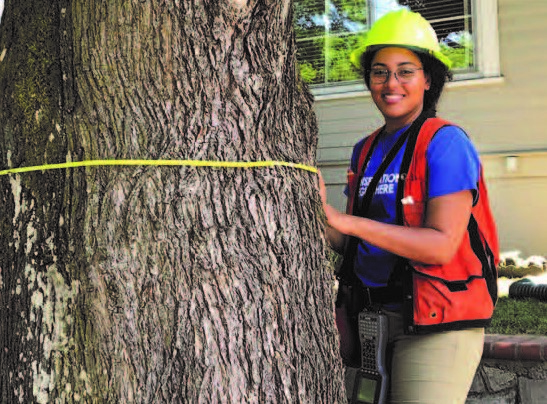Southern U.’s Brittany Benjamin Finds a Home in Urban FIA

This article appeared in the April issue of the Natural Resources Management (NRM) Today Newsletter as part of its Student Profile and was written by Steve Wilent.
Brittany Benjamin works for the US Forest Service’s Urban Forest Inventory and Analysis (FIA) program in Portland, Oregon, and San Diego, California. She’s also enrolled in an urban forestry Ph.D. program at Southern University in Baton Rouge, Louisiana
As a high school student in New Orleans, Brittany Benjamin had her sights set on being an English major in college and perhaps becoming a journalist. But when a recruiter invited her to enroll in a summer institute for high school students at Southern University (SU), all that changed. The program, Beginning Agricultural Youth Opportunities Unlimited (BAYOU), lets students “gain ‘first hand’ knowledge about career opportunities in Agriculture, Family and Consumer Sciences, and related disciplines” over three weeks at the university.
Of the Historically Black Colleges and Universities (HBCUs) in the US, Southern University is the only HBCU system in the nation. It is comprised of Southern University Baton Rouge, Southern University at New Orleans, Southern University Shreveport, Southern University Law Center, and Southern University Agricultural Research and Extension Center.
“We got to see the SU soil science program, plant science, animal science, urban forestry, textiles. Then Dr. Ning got up in front of the group and told us about what she does, what she teaches. She does research, writes papers, spends time in the lab and outside. She gave us her spiel, and I felt like she was talking directly to me” said Benjamin. “Dr. Ning walked out of a side door, and I walked out the back door, and I caught her, and I said I want to do exactly what you’re doing. I knew nothing about trees, I knew nothing about urban forestry, but she hit me with the science, the writing, being able to blaze your own path and come up with your own topic and share your research with the world. And I thought that sounded like the ideal job.”
Zhu Ning, an SU professor in urban forestry/ecophysiology and climate change, is chair of SU’s Urban Forestry and Natural Resources Department and its doctoral degree program leader.
“You can’t beat having Dr. Ning for a mentor,” Benjamin said.
Fast-forward a decade or so, and with bachelor’s and master’s degrees in urban forestry from SU, Benjamin works for the US Forest Service’s Forest Inventory and Analysis (FIA) program as a biological scientist focusing on urban forestry. She’s also enrolled in an urban forestry PhD program at SU Baton Rouge.
The FIA program has been in continuous operation since 1930. Its mission is to “make and keep current a comprehensive inventory and analysis of the present and prospective conditions of and requirements for the renewable resources of the forest and rangelands of the US.” In 2014, Congress expanded the FIA’s focus to include urban areas, with a special emphasis on the nation’s largest cities. Benjamin is based at the agency’s Pacic Northwest Research Station in Portland, Oregon.
Sample Plots
The rst thing Benjamin said when I asked her about her work at FIA, was, “I want it be known that I absolutely love my job.”
She then went on to describe Urban FIA.
“FIA started out as the nation’s tree census, focusing on rural areas, but trees in urban areas are forests, too—they are an important part of our natural resources. For doing a tree inventory, we have sample plots where we inventory any tree over ve inches in diameter within a 48-foot radius plot, and on four 6.8-foot micro plots we measure anything from one inch to 4.9 inches in diameter.”
Of course, Urban FIA inventories include data about much more than tree diameters.
“We collect data about tree species, crown condition and other damage, shrubs, groundcover, invasive plants, and other conditions,” Benjamin said.
Ground cover may consist of grass and plants or surfaces that are permeable (gravel, bare soil) or impermeable (asphalt, concrete). When trees are within 60 feet of a building, Urban FIA crews record the distance and azimuth between the tree and the building. If tree roots are compromising a road or sidewalk, or a power line poses a hazard as it passes through a tree canopy, such information is recorded.
Benjamin works in Portland and San Diego, two of numerous cities around the country where the Forest Service is conducting, or plans to conduct, Urban FIA inventories.
“Officially, I’m responsible for quality assurance, but I’m more like the boots on the ground—I’m basically a one-woman team when it comes to urban data collection,” she said. “I love being able to put so many skills that I’ve learned into practice, like GIS, managing databases, and publishing data. During the summertime, on a typical day I’ll be requesting access from landowners, and once we have access to their property, I establish a plot and do our sampling. Usually I can get through two plots in a day, sometimes three, depending on how many trees there are. This year I’m getting a crew, and I’m so excited that I’ll have some people working for me.”
Benjamin spends much of her time interacting with property owners.
“We get people who don’t want us on their property, who don’t want to deal with the Forest Service,” she said. “Just trying to nd out who owns a property can be pretty tricky, and that takes a good amount of my time. So I’m calling, texting, emailing, mailing, trying to fit our visit around their schedule.” Benjamin has noted a difference in the attitudes toward FIA between the two cities she focuses on.
“In Portland, the public is very engaged and interested in urban forestry—far more than people in San Diego are,” she said. “But homeowners in San Diego tend to know more about what they planted on their properties, because they have more influence over their urban forest. It’s pretty cool to see how well so many different species grow in San Diego. So we really have to know our trees. You could have one tree from Tanzania and have another one right next to it that’s from Asia. Sometimes homeowners may know where their trees came from, because they specially purchased them. But Portlanders are more engaged. They want to know what we’re doing; they want to tell us about their trees and what they’ve done to them. That can be super cool, super helpful.”
The City of Portland has been a willing cooperator with the Urban FIA inventory process.
“We are very engaged with Portland’s Urban Forestry Department,” said Benjamin. “They can’t always get onto private land, and the inventories they conduct cover only public property. So these data are something they have no other means to get.”
FIA data are publicly available for anyone to download; the agency does not reveal the exact locations of its plots, in order to protect the privacy of landowners who allow FIA eld crews onto their land, as well as to protect the plots from being disturbed.
“Most cities are on a 10-year cycle, meaning that it’s going to take us 10 years to visit all of the plots in those cities. Most cities have 200 plots, and we get about 10 percent of those every year. So every 10 years, FIA compiles all of the information for that cycle and publish reports about the urban forest in a city,” Benjamin said.
San Diego is on a ve-year cycle, and plots in both urban and rural areas are being inventoried.
My City’s Trees, a web-based application developed with FIA partners Texas A&M University and iTree, lets users explore urban forest inventory data associated with US cities. Data from Chicago was added in October 2021.
Return to the South
Benjamin’s goals for the future include assisting other students.
“My partner and I want to start a scholarship for Southern University urban forestry students—that’s something I’d like into put in the works very soon.”
She also looks forward to returning to the South.
“I want to eventually transition back to the South, to take my expertise back to my home. I am interested in all natural resources. Right now, the Urban FIA program is pretty small, and I really want to grow with this program and see where that can take me. I denitely want to stay in urban forestry and empower more people to be able to have the kind of career I have. Students at HBCUs are ready to work—it’s an untapped market. I might start a company or a nonprot that can help strengthen urban forestry in Louisiana, maybe hire urban forestry students to do FIA work. I’m taking a grant-writing course. I want to be able to write grants and obtain funding to be able to expand urban forestry in Baton Rouge and New Orleans, to get more young people involved,” said Benjamin.
“I want to inject as much of my knowledge and experience into Urban FIA while it’s still young,” she added. “I really appreciate that Urban FIA took a chance on me and that we been doing great things together. I can’t stress enough how much I just love this work. I get to jump in my truck, go to people’s houses, and hug trees all day.”
